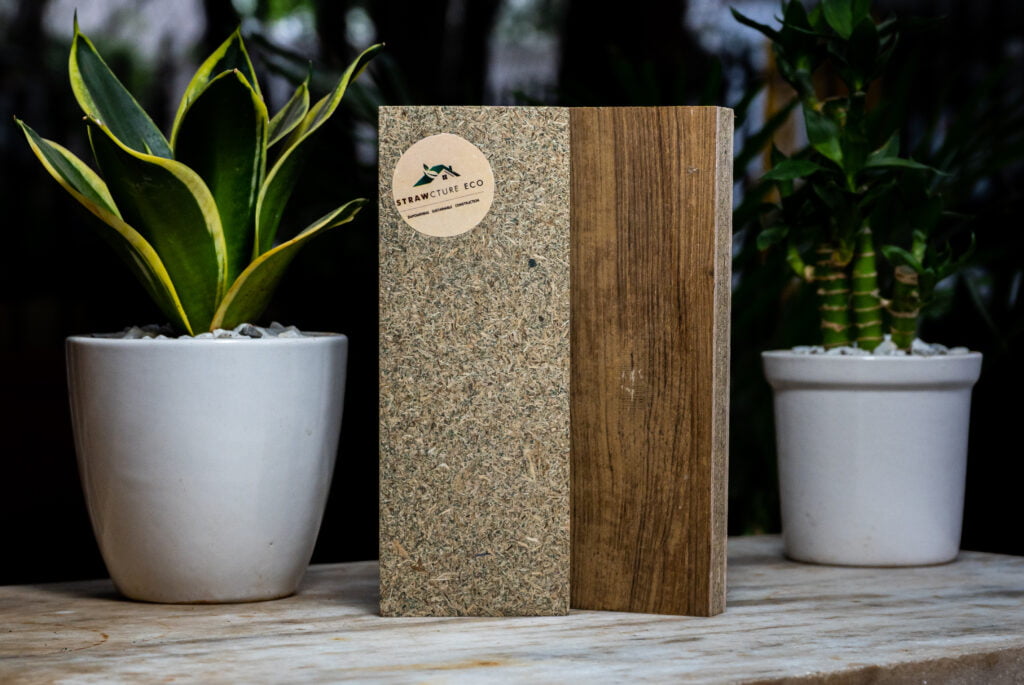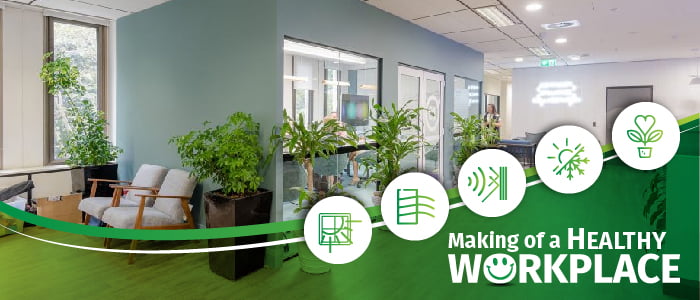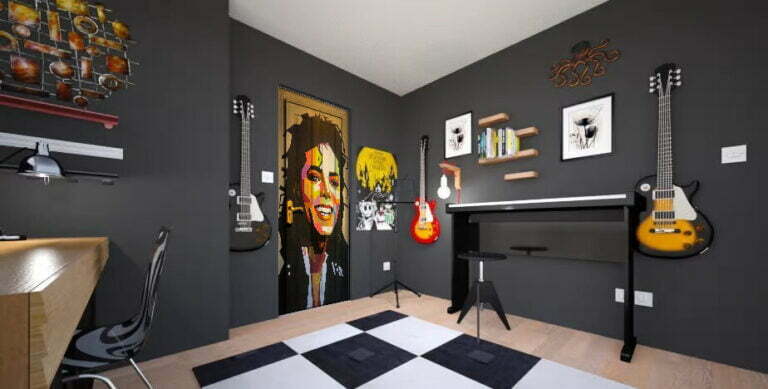Professionals spend a larger part of their lives at work. A healthy workplace, thus, is designed to have a positive impact on them. Apart from the company culture, various sensory elements contribute to the space’s ambience, comfort, and vibes.

The WELL Building Standard certifies and monitors the built environment features that impact human health and well-being. It measures and evaluates the built space as per seven parameters: air, water, nourishment, light, fitness, comfort, and mind. The WELL Standard believes that people’s health and wellness should be at the core of the building’s design.
A workplace designed with employee well-being as the core will yield improved productivity and a sense of security, thus sustaining employees and benefiting the company in the long run.
So how does one do that?
Architects need to factor in the construction ergonomics, considering daylight, air quality, acoustics, temperature control, biophilic design, and green building techniques.
Workplace environments designed with the above elements in balance actively reduce stress, are relaxing, and create positive vibes, helping achieve a balance between collaborative and individual working.

“Good architecture can help elevate mental well-being,” says the Director and Architect of DP Architects’ London Office, Frven Lim. Let’s look at why these five elements play a crucial role in defining the ambience and consequent productivity of a workspace:

Air Quality: Research shows poor air quality at work can significantly impair workers’ cognitive performance, including their ability to focus and respond quickly, negatively impacting their mental health.
It results in low energy and demotivated workforce, adversely affecting company productivity. The Harvard School of Public Health research revealed that impaired cognitive function was affected by PM2.5 and CO2 levels, a typical component of modern indoor environments.
It is reflective of offices with poor ventilation systems, trap waste air inhaled by employees causing illnesses like asthma, heart diseases, respiratory problems, and lung cancer.
To counter this, architects, while designing, are specifying
- E1-certified,
- low-VOC materials.
- Specify windows to allow for natural air ventilation.
Moreover, office operations need to avoid using chemicals and materials with high VOC emissions. Cleaning AC filters and ducts must be formalized per a calendar to keep them clean.
Conducting air quality tests would be an excellent way to keep all smart and maintain a good IAQ index.

Light
There is no doubt that lighting, whether natural light or electric light, significantly impacts people’s health and productivity.
Humans are greatly affected by the intensity, colour, tone, and type of lighting. Finding the right balance of white and yellow light, overhead and task lighting, and knowing where to build clear paths for natural light are all important aspects of a healthy workplace.
Therefore, architects must pay close attention when detailing this design aspect.
Architects are considering incorporating natural light sources in their design in the form of windows, skylights, etc., and plan the indoor lighting to ensure each workspace is lit well in line with the job requirement.

Acoustics
Noise is fatiguing, something that creeps on you even when you are not conscious of it. Open offices have added to this fatigue as noise levels are higher and privacy per seat lower.
A poor HVAC system, and a seat next to a printing station…all aggravate the situation. Over time, tapping keyboards or people talking distracts, adds to stress, and often manifests as headaches in employees.
In large, open-plan offices with many collaboration spaces, sounds reverberate, making the area noisy and uncomfortable.
Architects thus have resorted to incorporating acoustic panels in their designs. These are specified as components of false ceilings or drop ceiling panels, or wall panelling, depending on the space and the desired result. The intent is to arrive at the right sonic ambience for each workplace area, allowing for high intelligibility without the annoying echoes and hubbub, arriving at a quiet and comfortable workspace for the employees.

Thermal Comfort
When designing a workplace, indoor environmental quality involves the thermal comfort of the occupants. A study by the World Green Building showed that employee productivity is directly impacted by thermal comfort. Productivity will decline by 4% in a cold office and 6% in a warm one.
While HVACs provide a way to maintain workplace temperatures, using the material with natural thermal insulation could help reduce electricity bills and operational costs to keep the space comfortable.
Using an HVAC system that maintains Mean Radiant Temperature (MRT) is the next step to ensure thermal comfort.
Additionally, maintaining the functionality of the HVAC system by minimizing leakages in the building envelope to prevent too-hot or too-cold buildings is vital.
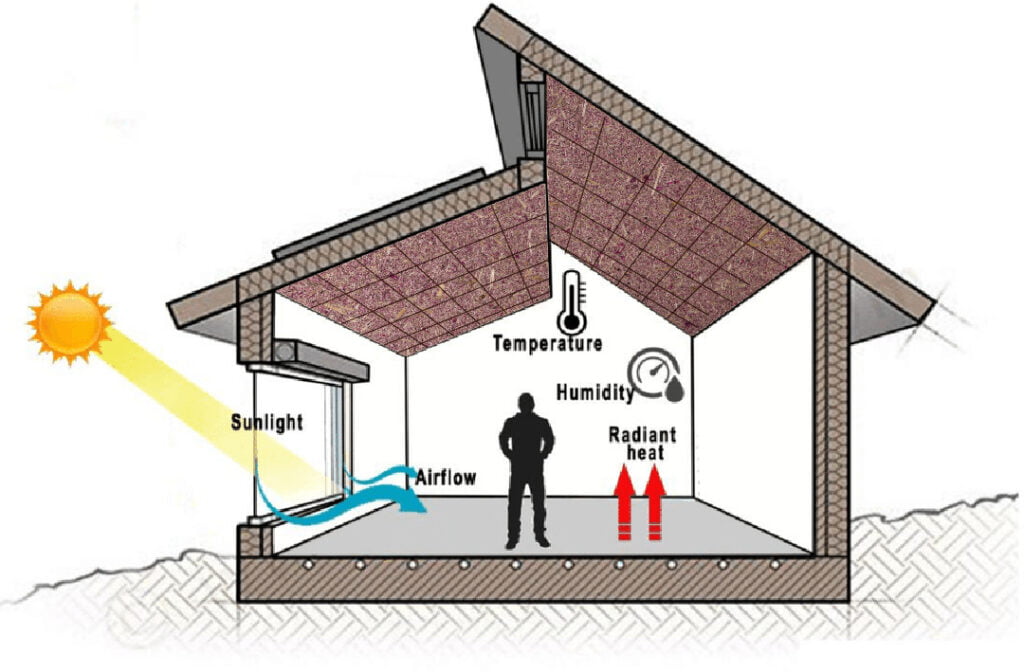
Sensors can be installed to monitor temperature levels indoors while leveraging automation systems outdoors can determine the optimum level of thermal comfort that helps improve employee morale and save on energy bills for employers, creating a win-win situation for both.

Biophilic design incorporates elements of nature into built environments in both architectural and interior design. Biophilic design is becoming an integral part of modern architecture based on humans’ intuitive connection with nature and the tranquillity it brings.
Biophilic designs aim to establish harmony between modern architecture and the natural world, improve employees’ quality of life, and increase productivity.
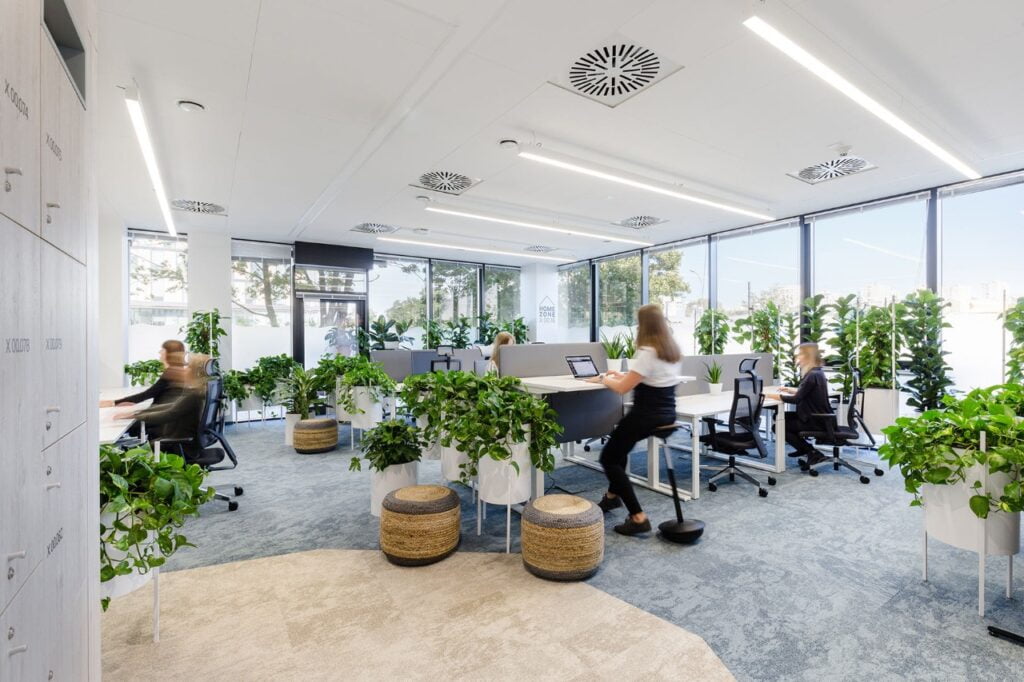
Strawcture’s Agribiopanels are made of 96% straw and proprietary binding adhesive making it the best eco-friendly product for all your furniture and construction needs. This green building solution can manufacture furniture panels that provide moisture resistance, thermal insulation, and termite resistance.
Strawcture’s Agribiopanels are a sustainable product that can be used for doors and provide good sound insulation.
It sequesters CO2, helps improve air quality, and is low on VOC emission. From wood to concrete-like appearances, these Agribiopanels are a canvas that allows you to transform your workplace into any aesthetic interior you desire.
